Visiting Cesky Krumlov Castle and UNESCO site
When I first visited Cesky Kromlov in Czechia, it was in early 2019. My husband and I stopped there because it is a listed UNESCO World Heritage site. World Heritage sites never fail to be interesting, no matter what country I visit. Cesky Krumlov did not disappoint.
I recently went there again as part of a press trip sponsored by Visit South Bohemia and Czech Tourism, yet even though it was my second visit, again Cesky Krumlov did not disappoint.
Another disclosure: This article contains affiliate links. If you click on one and make a purchase, I will receive a small commission. This will not affect your price.
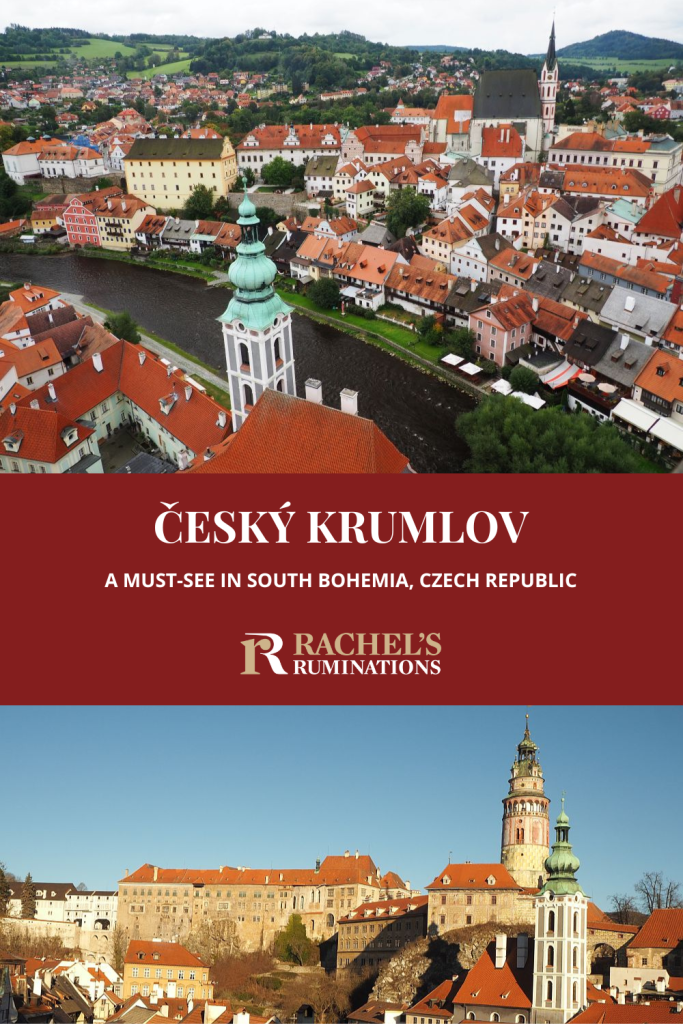
Cesky Krumlov (properly written as Český Krumlov), a completely intact medieval town, huddles around a meander in the Vltava River in south Bohemia. Its dominant landmark is a huge castle – second largest in Czechia after Prague Castle – looming on a rocky height in the middle of the town.

Cesky Krumlov Castle
Cesky Krumlov castle’s design and location emphasize its size: set on a rocky cliff overlooking the river, extended with a series of walkways over a cleft in the hill. The walkways make the castle appear even bigger than it is.
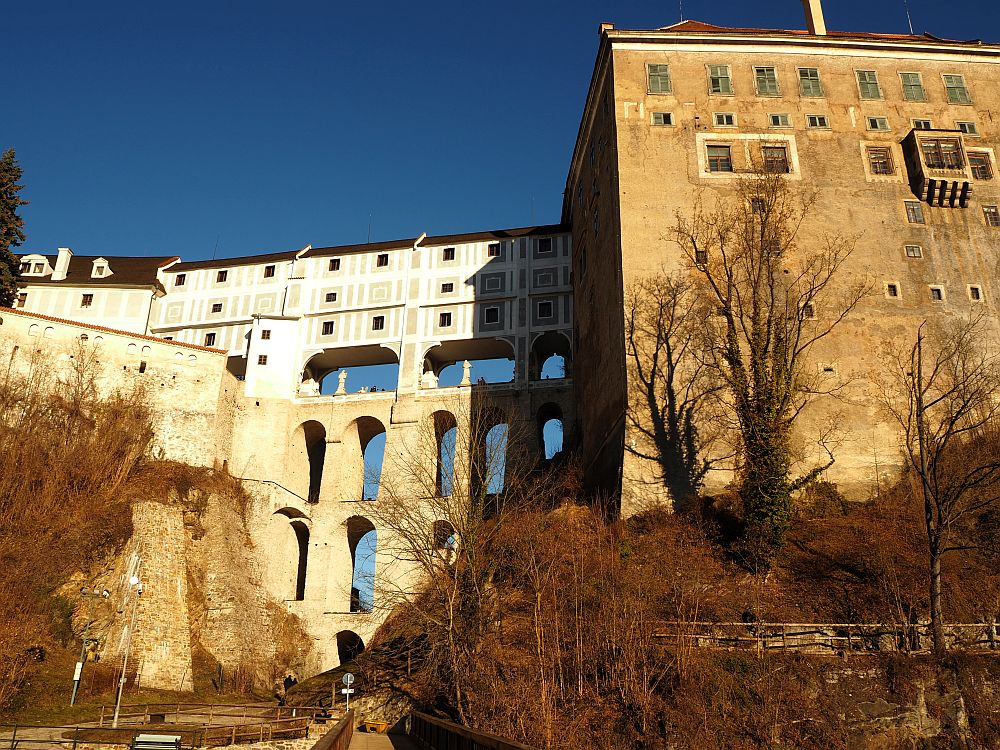
In fact, the castle is a collection of buildings positioned around the edges of the hilltop. You can look at the layout in the screenshot below, taken from Google maps.
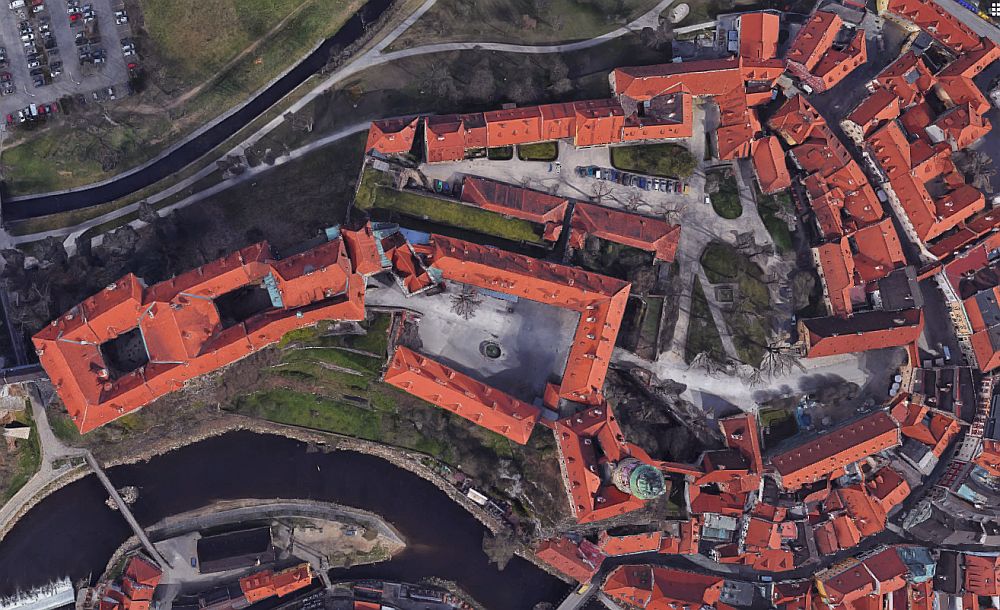
Originally built by the Vitkovci family starting in 1240, the castle passed to the Rosenberg family in the early 14th century. They’re the ones responsible for adding the imposing upper castle, and updating it over the next couple of centuries.
The Rosenbergs sold the castle in the early 17th century to Viennese Emperor Rudolf II, who gave it to a powerful family, the Eggenbergs. This family updated the castle to a baroque style.
When the Eggenberg line died out in 1719, the Schwarzenbergs inherited it, keeping it until after World War II, when it became a property of the state. (The Schwarzenbergs were the same family responsible for the Gothic Revival Hluboká Castle in South Bohemia.)
Today, the castle buildings combine elements of Gothic, Renaissance and Baroque design.
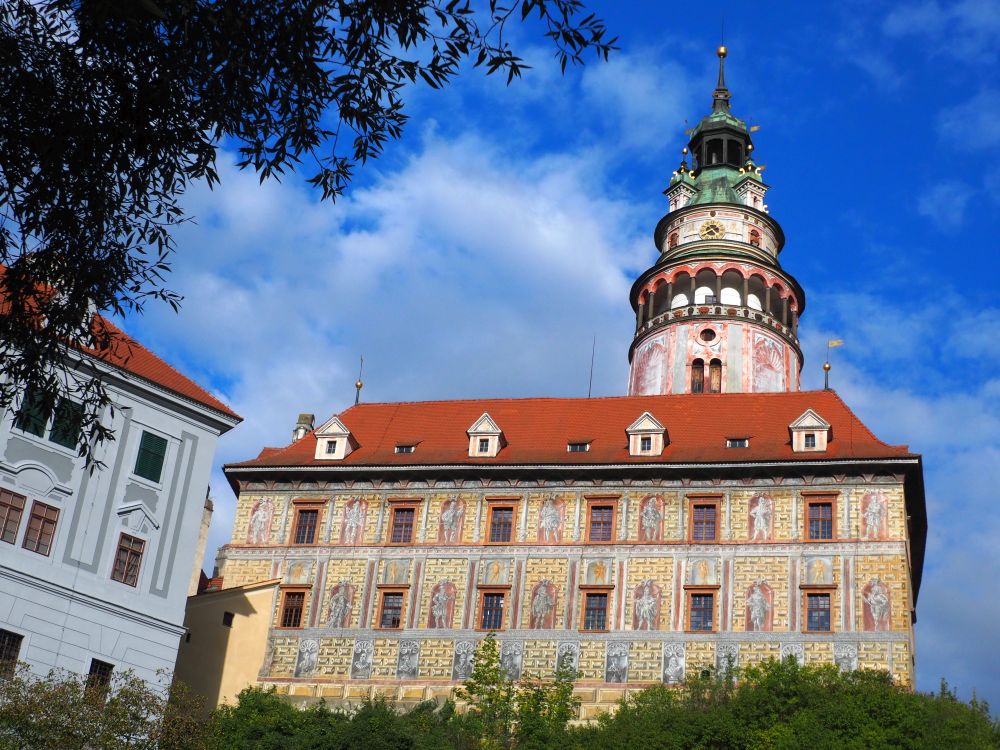
If you’re thinking of visiting Czechia, you really should check out these articles as well:
- UNESCO sites in the Czech Republic outside of Prague
- Five synagogues in Prague (and one cemetery)
- Visiting Karlstejn Castle from Prague
While the outside of the castle fascinates, on my first visit it was February: the wrong time of year to see the castle fully. The Czesky Krumlov Castle Museum was open, but was distinctly less interesting than the outside. A few rooms are furnished, but in a relatively modern form: the castle was used as an administrative building by the Czechoslovakian government after World War II. As you can imagine, the furnishings, such as they are, are more practical than elegant.
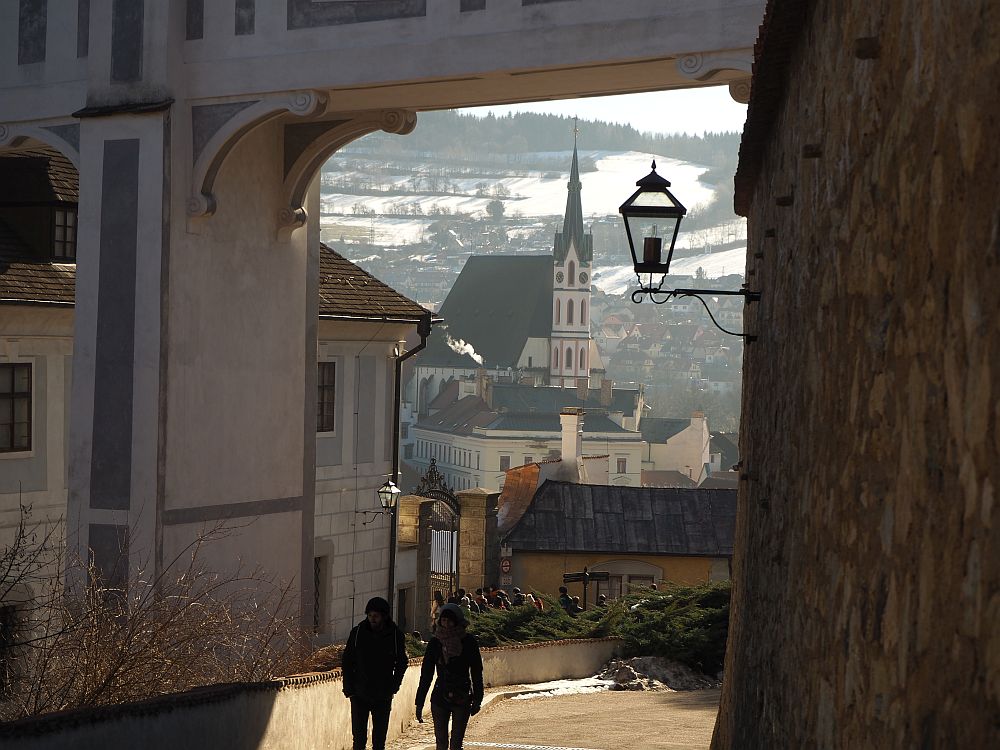
If you visit over the summer, you can take a guided tour to see some of the opulent period rooms upstairs. You can also tour the baroque theater, built in 1680-82 within the castle grounds. Still with its original mechanisms and sets, the theater is only used three times a year for a performance of a baroque opera. The garden is lovely too: restored to its full baroque formality.
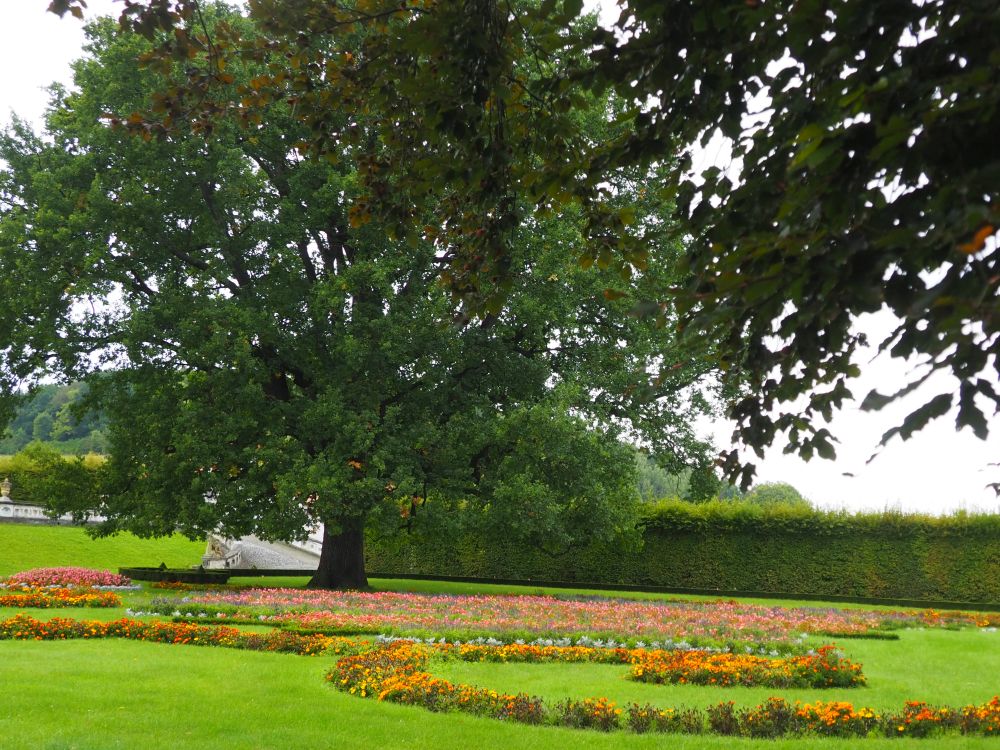
Views from the castle
Nevertheless, even without seeing the restored and furnished rooms elsewhere in the castle, it was worth its admission fee because of the views from the castle over the town and the countryside beyond. The bridge that forms a walkway over the cleft in the hill allows wonderful views for little effort.
The views from up in the tower are even more amazing, though it takes some effort to climb it: 162 steps, to be exact.
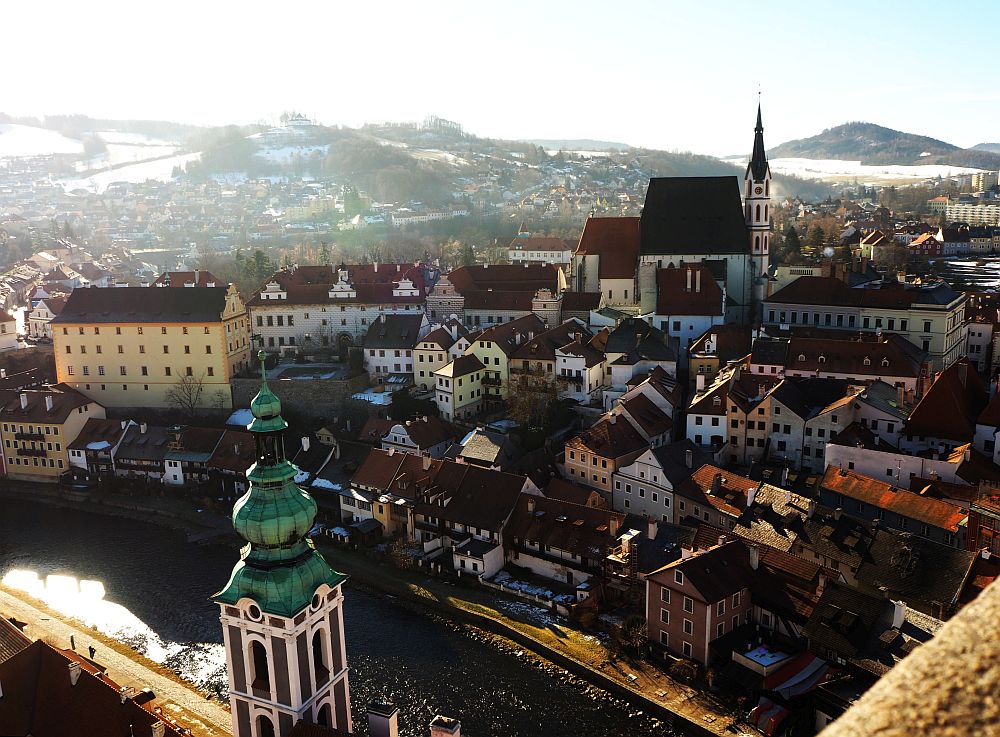
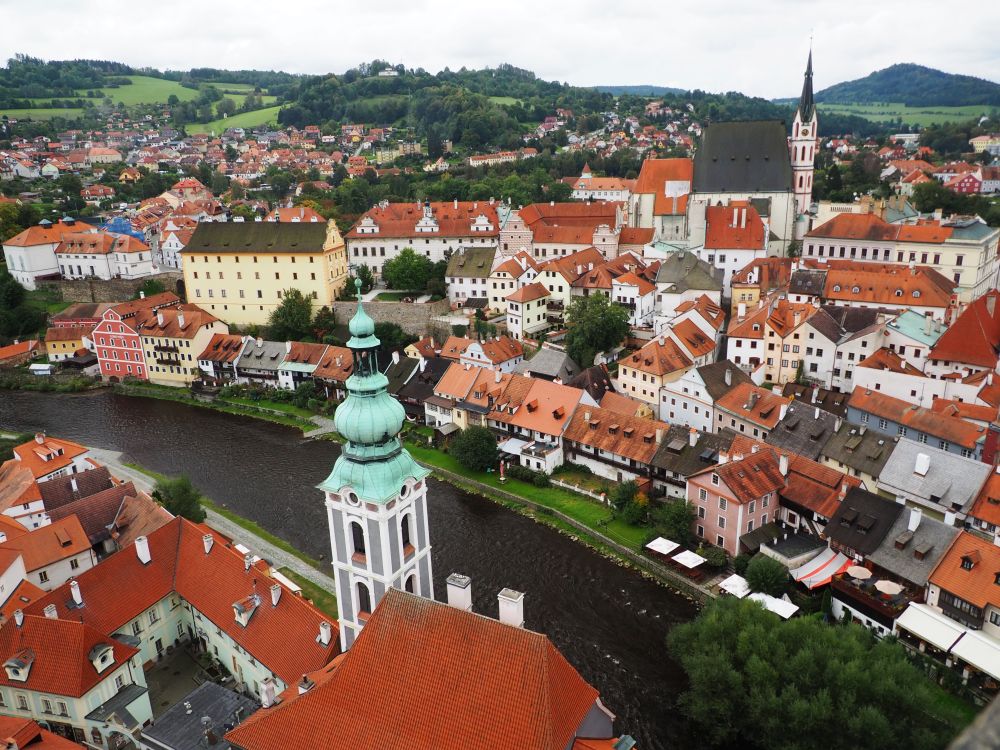
Things to do in Cesky Krumlov UNESCO site
Cesky Krumlov Castle is only one part of the UNESCO World Heritage designation. Officially, the site includes the whole historic center: “an outstanding example of a small central European medieval town whose architectural heritage has remained intact thanks to its peaceful evolution over more than five centuries,” according to the UNESCO website.
Once you’ve looked at the town from high in the tower, you’ll want to go see it up close. Cesky Krumlov isn’t a big town, and you’ll end up covering most of it by just strolling around randomly.
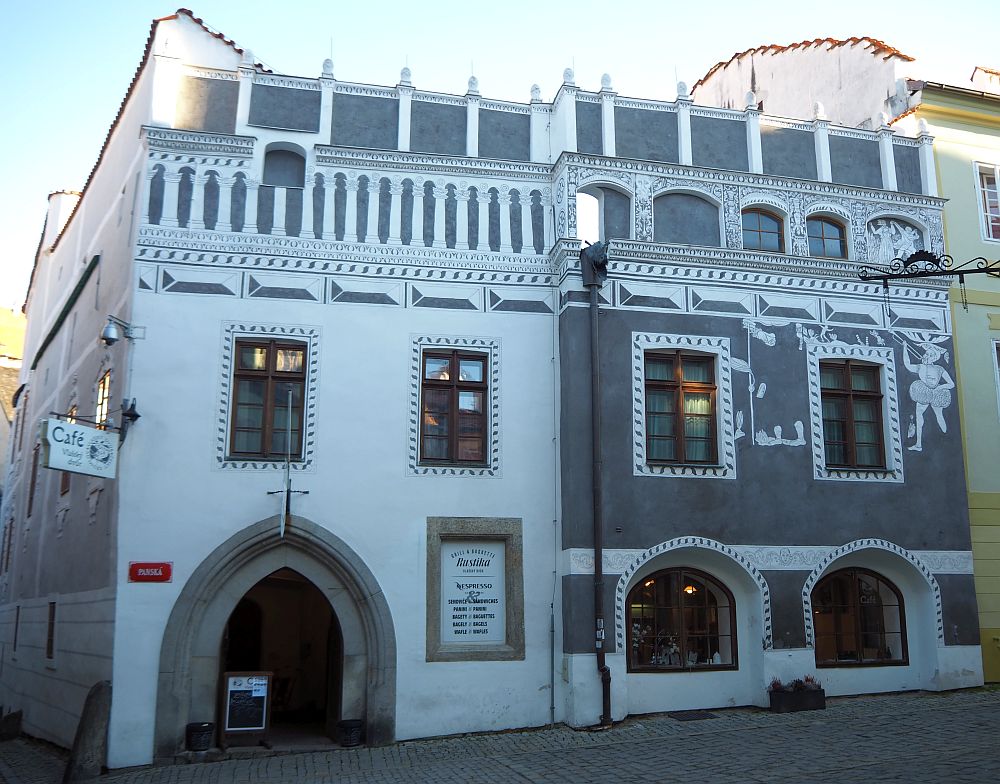
And that stroll is an absolute joy at every turn. The cobbled streets twist and turn, crowded with shops and restaurants. Many of the buildings, which span the 13th to the 18th century, have been beautifully restored. In particular, make sure to look up at their facades, boasting a variety of artworks in stucco or paint above the ground floor. Here is just a small sample:
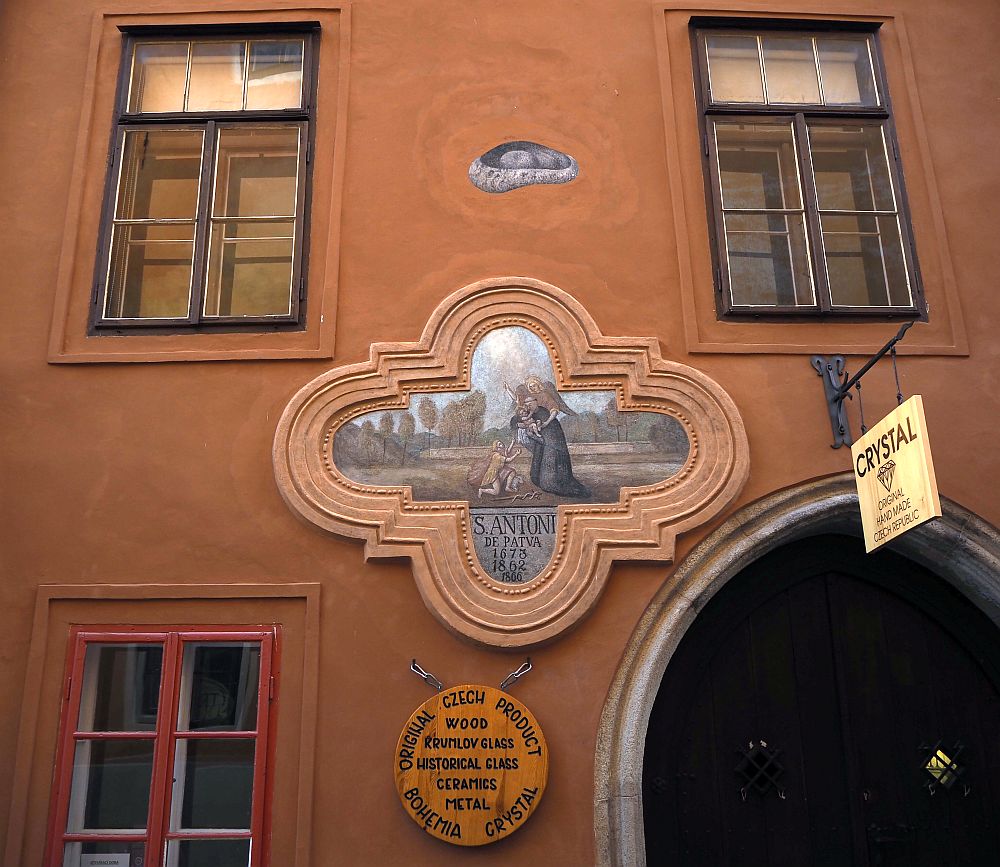

Namasti Svornosti, the old town’s central plaza, is where you’ll find the 16th century town hall and a plague column (1716), common to many towns in Czechia.
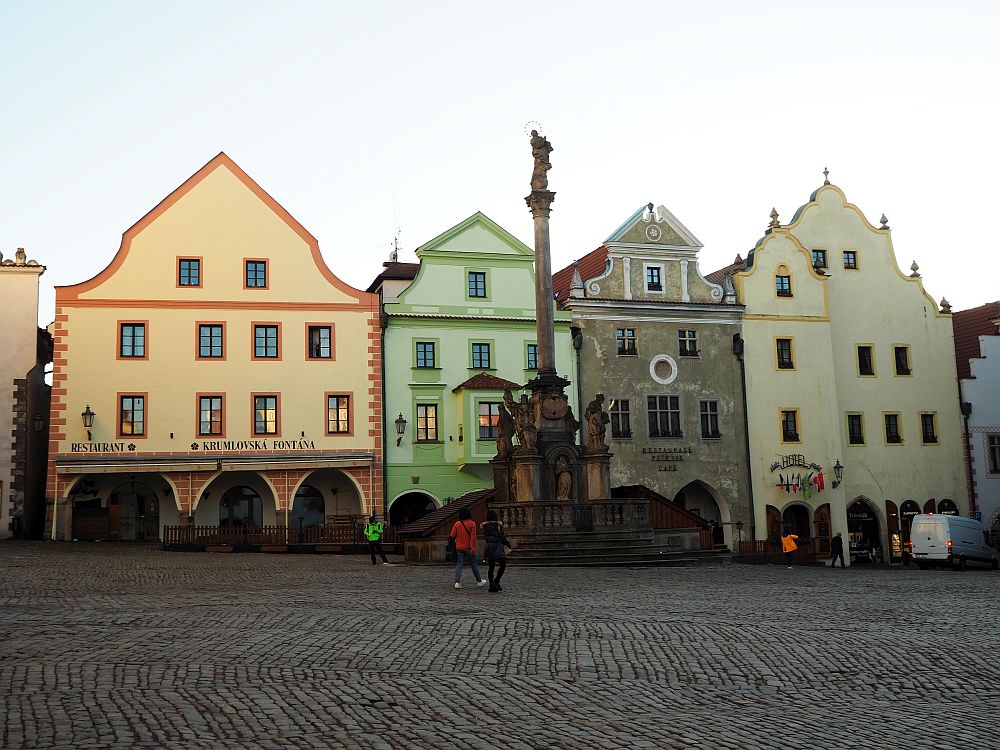
Just above the river stands the lovely St. Vitus Church. The gothic structure dates from the 15th century, and some frescos from the same century are visible inside. Check out the huge 17th-century Baroque altar.

Much of the interior, though, is Neo-Gothic, meaning it was renovated in the 19th century. The tall steeple, seeming even taller because of the church’s setting on a small rise, is also a 19th century addition.
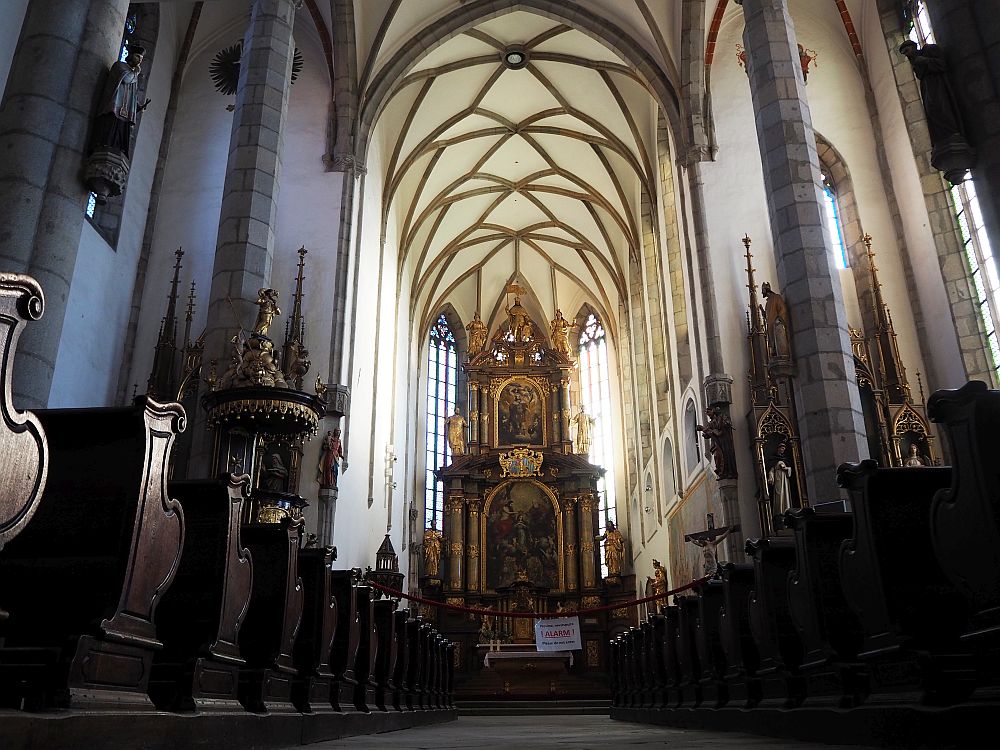
Cesky Krumlov from the river
Because the river Vltava meanders around the town, traveling on the water gives views of the town and the castle from all sides. On the press trip I took recently, our group enjoyed a raft ride along the river, offered by Rafting Malacek. They also rent canoes, but the boat we took was a raft.
The Vltava used to be an important form of transportation, particularly for moving logs downstream. They would be strapped together and poled down the shallow stream by a polesman standing at the back of the raft. Malecek has revived this tradition, though the rafts are more boat-like now and accommodate passengers in wooden seats.
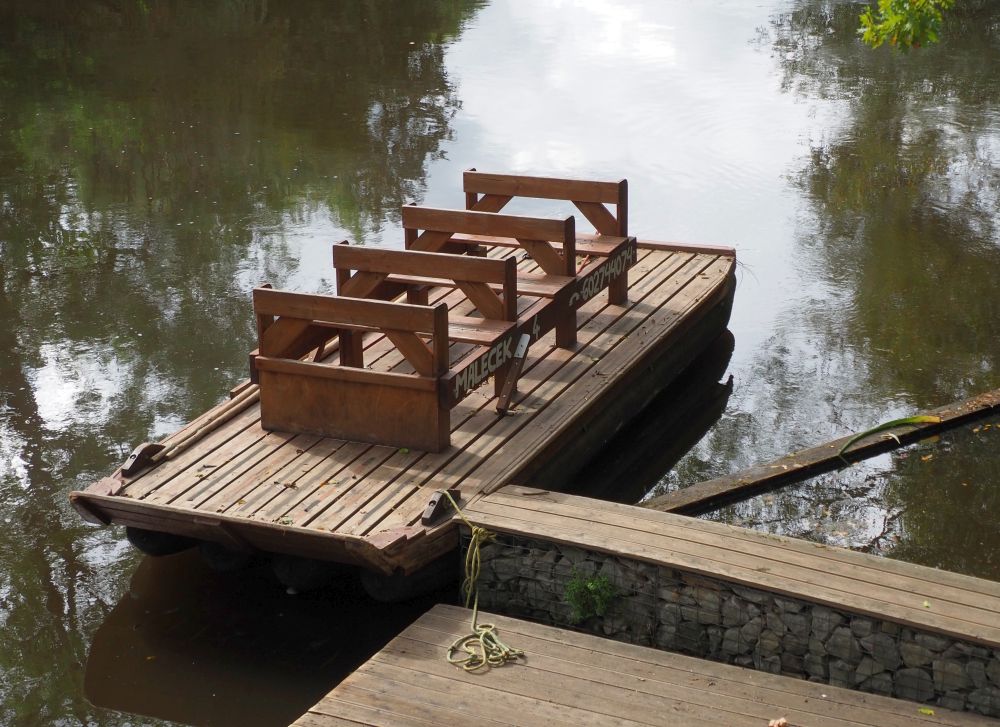
The river around the old city is shallow and the water doesn’t run very fast – except in the two weirs which are, essentially, low dams used to control the river’s change in level. Each has been designed with a sort of chute at one side, specifically to allow rafts to descend to the lower water level.
Our boatsman, while he poled the raft along, told us much about the history of the town and the rafts. He pointed out highlights as we went, and positioned the raft so we could get pictures. As a local, he could also tell us what life is like for the people who live here and how the town has changed since it was “discovered” as a tourism destination.
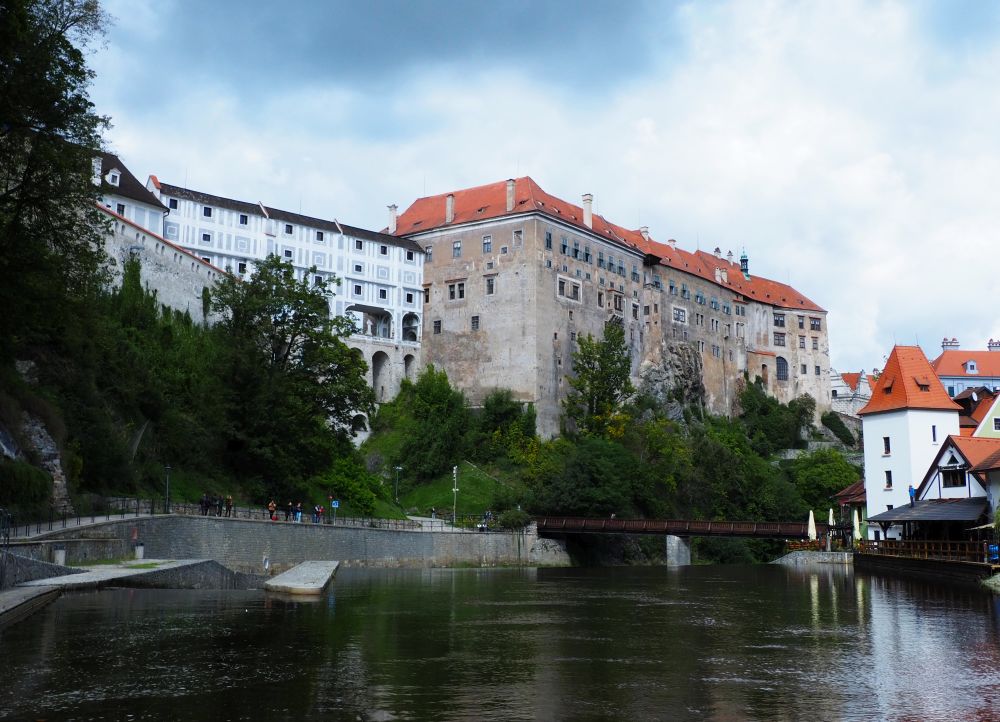
While it would also be fun to rent a canoe and get around by yourself, the added value of the polesman acting as tour guide leads me to recommend the raft over the canoe.
The Czech Republic has a lot to offer beyond Prague, and I certainly think that Cesky Krumlov should be high on your list. This is one of the most picturesque towns I’ve ever visited.
Getting there from Prague
Visiting Cesky Krumlov is quite doable as a day trip from Prague. It would be a long day, though: about 3 hours on a FlixBus or RegioJet bus from Prague each way. Driving takes about 2.5 hours each way.
It will be a much more relaxed visit if you stay a night or two, with the added benefit of enjoying the town in the early morning or late afternoon when there are fewer tourists around.
An alternative is to take a small group or private tour from Prague. It’s the easiest way because you don’t have to find your way around the bus system and you can leave the driving to someone else. The link will take you to a choice of several such tours.

Details for visiting Cesky Krumlov
Admission times and prices vary depending on the time of year, how much you want to see, and whether you take a tour. See their website for details.
- Cesky Krumlov Castle Museum and Castle Tower are open all year, though the days and times shift. It can be visited individually, i.e. without a guide. In the winter it’s closed on Mondays, and closes earlier in the afternoon.
- Cesky Krumlov Castle Tour I (guided) includes Renaissance and Baroque interiors, some with wall paintings and decorative ceilings.
- Cesky Krumlov Castle Tour II (guided) is mostly about the Schwarzenberg family, including a portrait gallery and a whole series of furnished rooms.
- The castle garden (unguided) is open daily in April-October. Admission is free.
- The Baroque theater has very limited hours: again, check the website for details.
- The Baroque stables (unguided) are in a Renaissance building next to the baroque theater.

Have you been to Cesky Krumlov? Do you have any comments or tips? Add them below!
My travel recommendations
Planning travel
- Skyscanner is where I always start my flight searches.
- Booking.com is the company I use most for finding accommodations. If you prefer, Expedia offers more or less the same.
- Discover Cars offers an easy way to compare prices from all of the major car-rental companies in one place.
- Use Viator or GetYourGuide to find walking tours, day tours, airport pickups, city cards, tickets and whatever else you need at your destination.
- Bookmundi is great when you’re looking for a longer tour of a few days to a few weeks, private or with a group, pretty much anywhere in the world. Lots of different tour companies list their tours here, so you can comparison shop.
- GetTransfer is the place to book your airport-to-hotel transfers (and vice-versa). It’s so reassuring to have this all set up and paid for ahead of time, rather than having to make decisions after a long, tiring flight!
- Buy a GoCity Pass when you’re planning to do a lot of sightseeing on a city trip. It can save you a lot on admissions to museums and other attractions in big cities like New York and Amsterdam.
- Ferryhopper is a convenient way to book ferries ahead of time. They cover ferry bookings in 33 different countries at last count.
Other travel-related items
- It’s really awkward to have to rely on WIFI when you travel overseas. I’ve tried several e-sim cards, and GigSky’s e-sim was the one that was easiest to activate and use. You buy it through their app and activate it when you need it. Use the code RACHEL10 to get a 10% discount!
- Another option I just recently tried for the first time is a portable wifi modem by WifiCandy. It supports up to 8 devices and you just carry it along in your pocket or bag! If you’re traveling with a family or group, it might end up cheaper to use than an e-sim. Use the code RACHELSRUMINATIONS for a 10% discount.
- I’m a fan of SCOTTeVEST’s jackets and vests because when I wear one, I don’t have to carry a handbag. I feel like all my stuff is safer when I travel because it’s in inside pockets close to my body.
- I use ExpressVPN on my phone and laptop when I travel. It keeps me safe from hackers when I use public or hotel wifi.


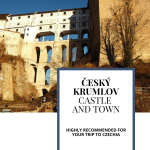
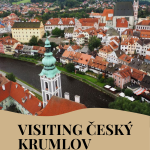
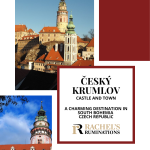
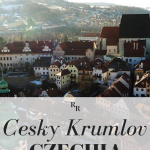

Loved Cesky Krumlov – it’s such a lovely town for wandering and the surrounding area has a lot to offer too! It’s wonderful in summer – but packed with people, so Feb might be a very good time to visit!
It was, at least for strolling. We didn’t get to see what sounds like some pretty rooms in the castle because neither of the tours was running. And the stable, theater and garden were closed.
We were in Cesky Krumlov in October, 2017 and loved the town. Thank you for doing such a fine job of bringing back those lovely memories.
How does the free castle museum compare with the guided interior tour? The day we are visiting, the tour is not running, unless we change our itinerary completely (not preferably), which is okay if the guided tour is worthwhile. I would love to see the interior, but changing up the interior means wasted travel time.
The castle museum isn’t particularly interesting. I haven’t taken the guided interior tour, but if you like opulent interiors, it sounds like it might be worth changing your plans. So would being able to see the baroque theater, if that’s your thing. Having said that, I was fine with missing both. If they’re not so important to you, there’s plenty to see with just an admission ticket to the castle grounds and to see the views from the castle.
Thank you for the insight!